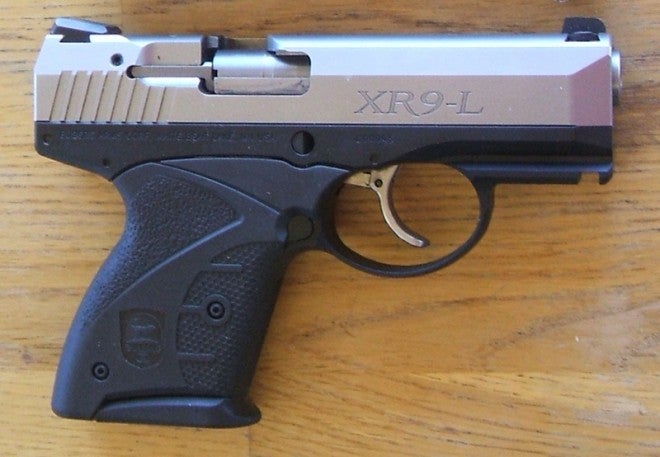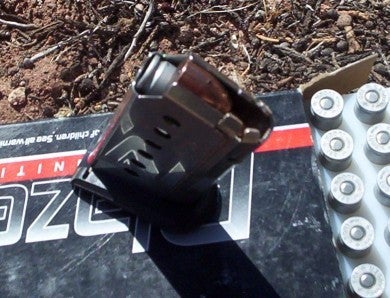Boberg XR9-L Review

There are really no new ideas in firearms design today – some of the best and brightest engineers humanity has produced have spent the last 120+ years figuring out every possible mechanism for building self-loading firearms. What we have today in new guns are creative new ways to put together various different design elements in new ways to make more efficient and reliable guns. The Boberg XR9-L (and its shorter companion piece, the XR9-S) is a pretty slick compact carry gun that harkens back to the original monster hand cannon, the Mars Automatic Pistol. What makes the Boberg so interesting is that it feeds cartridges backwards out of the magazine, instead of the standard method of pushing them forward – like the Mars did. This requires a pretty creative feed system, and all for the end goal of getting a long barrel in a short pistol.
BOBER XR9-L
Check out the review video for footage of the Boberg shooting, and to see up close how it works mechanically: Boberg XR9-L Review Video
The Boberg XR9-L manages to squeeze a 4″ barrel into a gun with an overall length of barely 6 inches. Why go to all the work of designing an unconventional pistol for that one feature? Well, it lets you get the most possible performance out of the 9mm cartridge. Judging from the data at Ballistics by the Inch, that extra inch of barrel length gets you 100fps more velocity with many brands of ammo – or in another view, it gives you +P performance from standard cartridges, compared to the 3″ barrel in any other pistol the size of the XR9-L. The question is, how much are you willing to sacrifice for that extra velocity?
Before I start drawing conclusions, though, let’s take a look at how the Boberg handles and shoots. It’s really quite nice, the recoil in particular. The grip design and locked breech design really help mitigate the recoil, and the XR9-L is a very comfortable pistol to shoot (unlike many compact handguns). The trigger is long, but smooth, and I have no doubt it will deliver excellent accuracy for any shooter accustomed to DAO pistols (I didn’t shoot it for groups myself, instead using steel plates – which I had no trouble hitting every time as long as I paid attention to my sight picture and trigger control).
Magazine design on the Boberg is a definite departure form what one expects to see. Since it feeds backwards out of the mag, cartridges are held nose-down, and the feed lips are folded down around the nose of the rounds to hole them securely in position. No follower is used in the magazines; instead the magazine spring pushes directly on the bottom cartridge. This seems like it would be a source of problems, but I had no problems with the magazines through my shooting.
What I did have trouble with was ammunition. The backwards feeding of the Boberg is not what cartridge companies expect their ammunition to be subjected to, and that backwards yank out of the magazine puts a lot of stress on the crimp of the bullet in the case. With the first two brands of ammunition I tried (generic factory reloads and Blaser aluminum-case), every third or fourth round would malfunction in a very novel way. The slide would actually pull the case off the projectile, leaving the bullet sitting lonely in the magazine feed lips while the powder fell out and the now-empty primed case either stovepiped on feeding or fed and made a sad “pop” on firing.

When I dropped the mag to clear the malfunction, this is what I found.
To be fair, Boberg doesn’t conceal this behavior – on the contrary, they keep a running list of ammo brands that both work well and are known to malfunction. When I found a brand in my stash that didn’t give problems (Fiocchi), it ran flawlessly. It was accurate, it pointed well, it was comfortable, it was concealable…but I don’t know if I could really be confident in it as a carry gun. The problem is that providing a particularly strong case crimp to hold the bullet in position isn’t really something ammo manufacturers pay a lot of attention to – because no other firearm on the market is putting this type of strain on cartridges. A brand may work fine today, but a change in tooling or process at the plant could result in ammo that would give the Boberg problems, without any forewarning. If I was to buy and carry an XR9, I would want to buy a big batch of whatever ammo I plan to carry, and then run several hundred rounds to test it with the pistol, and then only use that lot for carry ammo, and practice with other stuff. Last year’s Gold Dots may not be the same as next year’s (well, bad example – Gold Dots are on the don’t-use list).
It’s like driving an Indy car that does everything right, except will sometimes just stall out, and require you to bleed the injectors to get it restarted. While it would be a lot of fun to drive in practice where an occasional stall didn’t really matter, would you really want to take a chance on it at a real race?
To make things worse, look at the price. A base model (two-tone) XR9-L lists on Boberg’s web site for $1,095. That’s a lot of money for a pocket pistol. If you want it all the same color, you’re looking at $1,399. I can get a lot of other guns for half that amount, and know that they will be reliable with any decent ammo. Is the Boberg’s extra inch of barrel worth the price and the ammunition issues?
To me…no. Sorry, Boberg. I love mechanically unusual firearms, and the XR9-L really appeals to me for that reason, and it’s beautifully made. If it were something more suited to casual plinking, I’d be willing to overlook the ammo sensitivity. But it’s very much designed to be a carry piece, and I can’t overlook the possibility of a really nasty malfunction occurring when I most need the pistol.
For the record, the gun I shot was purchased new by a friend, and was not a sample gun sent by Boberg Arms.